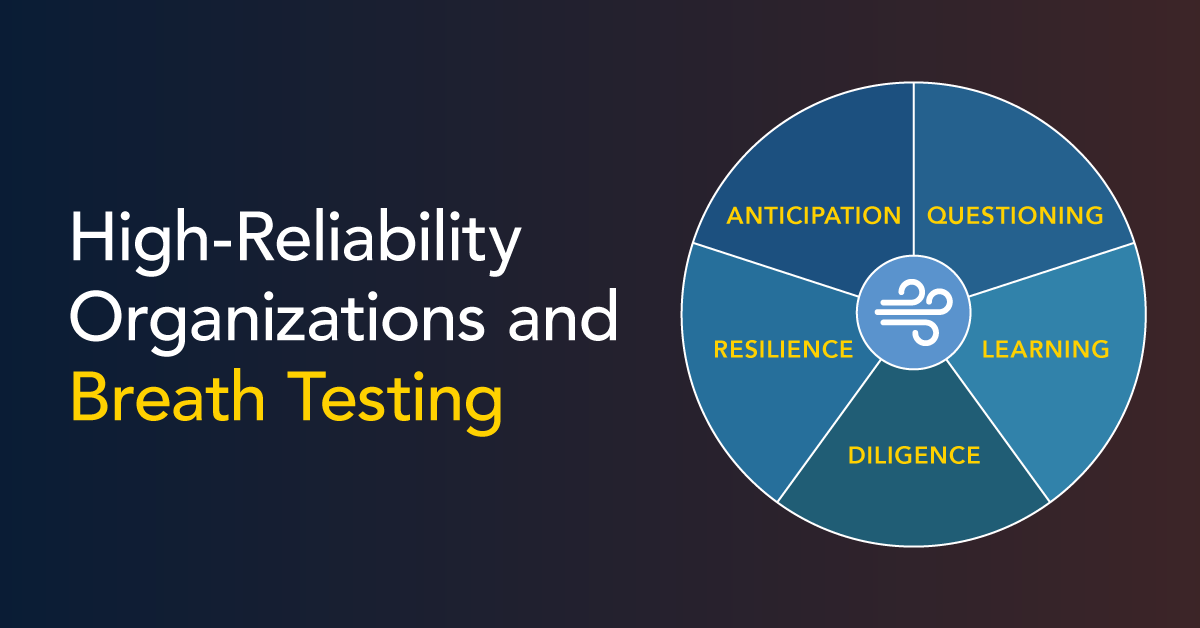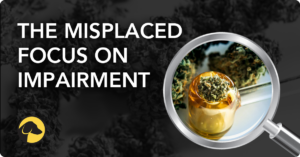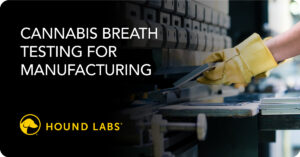
Could Testing Breath for Cannabis Help Avoid a Catastrophic Safety Accident?
In a recent article in EHS Today, Mike Snyder wrote about “The 5 Disciplines of High-Reliability Organizations,” or HROs. HROs are companies that put a premium on proactively addressing the factors that contribute to catastrophic safety risk in their organizations. This article struck a chord because the 5 disciplines detailed by Mr. Snyder are the same ones that HROs and other companies can use to establish and evaluate their workplace testing programs. This framework provides even more value to companies who may be reconsidering the value of workplace cannabis testing.
Contrasting BP’s devastating Deepwater Horizon oil spill with proactive measures taken by ExxonMobil a few years earlier to avoid a similar incident, Mr. Snyder provides some guidance on how HROs can stay safe despite operating in high-risk conditions. By focusing on 5 practices (anticipation, questioning, diligence, resilience, and learning), companies can establish themselves as an HRO and avoid many mistakes that can lead to costly accidents. In this blog, I explore how integrating breath testing for cannabis aligns with the disciplines of HROs and can provide guidance for companies that are reexamining existing drug testing programs or creating new ones.
ANTICIPATION – “Recognizing early warning signs.”1
With the legalization and acceptance of recreational cannabis use, employers are logically experiencing an increase in cannabis use in the workplace. In the last 5 years, there has been a 60% increase in the number of employees getting high at work.2 Even if a company hasn’t experienced an increase in the positivity rates of cannabis testing, a quick review of recent data from Quest Diagnostics indicates that employers should anticipate problems. Quest’s research stated that the “marijuana positivity rate of post-accident test results grew faster than the rate for pre-employment testing.”3
Anticipating the potential impact of cannabis legalization should drive employers to revisit their drug testing policies with a focus on cannabis testing. Specifically, implementing “post-hire testing” – drug testing 100% of new employees with breath testing technology within a designated period after their hire date – will help companies identify employees who used within hours of the test. By using breath testing for post-hire testing, companies will only identify employees who used very recently – not those who used days or weeks before the test and are no longer impaired. It also allows companies to identify employees who are not in compliance with their cannabis use policy before they invest fully in new employee training. Coupling post-hire testing with pre-access testing deters and detects cannabis use immediately before and while at work, which are both important to preventing accidents.
QUESTIONING – “Preserving the integrity of decision-making” while avoiding bias.4
The new automated breath technology found in cannabis breathalyzers like the HOUND® CANNABIS BREATHALYZER provides employers with objective data on location about recent cannabis use. The Hound® solution provides instrument-read results of breath samples, eliminating the potential for bias because the results do not need to be interpreted by the test administrator. Results are processed and analyzed with the press of a button.
Objective, on-location results from a cannabis breathalyzer also help employers address employee concerns about the limitations of traditional cannabis tests (oral fluid, hair, urine). These categories of cannabis testing have long detection windows that may result in situations where bias can be prevalent. For example, a shift worker who tests positive on a urine test may share with a manager that she used legal cannabis at a family BBQ over the weekend, but absolutely did not use during work hours. In this scenario, the manager may be influenced by biases that impact whether the manager believes the shift worker’s explanation. Utilizing breath testing for recent use provides objective data about whether an employee used during work hours – corroborating the shift worker’s statement. Ultimately, testing for very recent cannabis use avoids the issue of what employees do on their personal time because breath testing for cannabis does not test for past use.
Finally, frequent, standardized use of cannabis breath testing allows employers to make unbiased evaluations about possible on-the-job drug use that may impact productivity and safety, avoiding situations in which they are relying solely on subjective signs of cannabis use at work.
DILIGENCE – “Assuring the consistent and reliable use of all programs and processes to deliver reliable and safe outcomes.”5
Snyder states that “the key to assuring consistent and ongoing activity is developing leaders who monitor, reinforce and verify effective program execution.” He further states that “human performance reliability is key to good diligence.” These statements get at the heart of comprehensive drug testing programs and their associated processes. The best drug testing programs allow for reliable and predictable implementation of drug testing protocols so both employers and employees know what to expect. Workplace drug testing programs indicate (among other things) who will be tested, when they will be tested, what types of tests will be used, and the consequences. A comprehensive drug testing program strives to maintain safety while also ensuring fair treatment of employees.
However, some believe that the legalization of recreational cannabis may be jeopardizing the achievement of both goals. Companies that do not do their diligence and rely solely on traditional tests risk fairness to employees. Companies that eliminate cannabis testing risk safety for employees. In contrast, companies that add breath testing for cannabis to their programs will be better able balance both SAFETY+FAIRNESS™.
RESILIENCE – “Developing the agility to recognize and quickly respond to exposures in real time.”6
Most employers who want to prevent drug use during work hours adopt drug testing programs. However, accidents and safety violations may still occur. At these times, employers need to recognize whether drug use, including cannabis use, may have contributed to the accident. Employers want to know this for several reasons. First, if an employee causes an accident because of cannabis use on the job, employers will handle this differently than if test results are negative. A positive test for cannabis use indicates use immediately before or during work and warrants action from the employer. A negative result could indicate the need for more robust training on safety protocols. Second, if a cannabis test provides positive results, employers want to know whether the cannabis use occurred during work hours within a time frame that could have caused the safety violation. Only cannabis breath testing provides a window of detection that aligns with work hours or a typical 8-hour shift.
Identifying recent cannabis use will help employers learn not only about each individual safety accident or violation but will help employers recognize trends. Does the company have an increasing cannabis positivity rate after accidents? Has the increase occurred since legalization? Can the company determine if the positive cannabis tests relate to recent use or instead are due to legal use during employees’ personal time? Using the latest breath testing technology will help companies understand the importance of both the negative and positive results of workplace cannabis tests.
LEARNING – “Resilient organizations make learning routine rather than waiting for an incident to trigger learning activities.”7
To develop a safety-centric workplace and culture, the most effective HROs value ongoing education and training. Prioritizing education and training helps companies mitigate risk. Because workplace drug testing programs aim to reduce physical risk to employees and customers, financial risk to companies, and reputational risk to a company’s brand, most HROs have developed and invested in best-in-class programs. These companies do more than establish the program – they also understand the importance of communicating the benefits to employees. Employees want a safe work environment, and a well-developed communication plan helps employees learn that workplace drug testing should be one of the cornerstones of a good safety program. Employees also want to be treated fairly, which is why some employees are proactively recommending that their employers adopt the HOUND® CANNABIS BREATHALYZER. These employees do not want their employers to drop cannabis testing, but they do want a fair test that maintains their privacy outside of work hours.8
As cannabis legalization spreads and businesses struggle with how to approach drug testing in this new era, can a company that decides not to test for cannabis still claim they are following the practices of an HRO? For those embracing the benefits of maintaining or establishing an HRO culture, breath testing for cannabis will become integral. Designed during the era of cannabis legalization to maintain safety and fairness™, the HOUND® CANNABIS BREATHALYZER can be a critical tool that helps HROs succeed as they address the risk factors associated with catastrophic safety failures.
Footnotes
1 EHS Today, Safety Leadership - 5 Disciplines of High-Reliability Organizations
2 https://www.remedyreview.com/data/survey-high-at-work/
3 PR Newswire - Quest Diagnostics Drug Testing Index™ Findings
4 EHS Today, Safety Leadership - 5 Disciplines of High-Reliability Organizations
5 Ibid.
6 Ibid.
7 Ibid.
8 Statement based on Hound Labs’ conversations with employers.

September 26, 2021
By NINA M. FRENCH
Share












